Cindy Thomson's Blog
November 10, 2025
Scotland’s Book Town
In the 1990s, a small Scottish town called Wigtown on a peninsula reaching out into the Irish Sea was struggling. Its residents could not find work. Two major industries had shut down and the historic buildings fell into disrepair. This was also the time the idea of designating one of Scotland’s towns as the national book town was floated as a way to regenerate depressed areas of the country. Ultimately, Wigtown was chosen from a short list of six places. One of the reasons was that Wigtown had so many empty buildings in its town square, buildings that could hold several book shops. It was also a beautiful area with a rich history. Fast forward to today and there are about 20 bookshops and book-related shops. We visited all we could. Some were closed in the middle of the week when we were there. We still got to see many, and got to eat inside one.
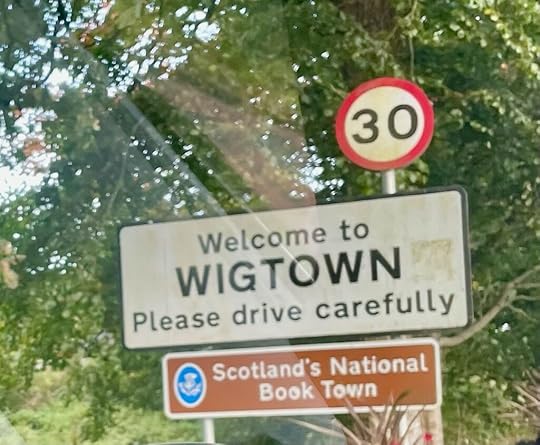
The designation as Scotland’s Book Town came in 1998, the same year that the town hosted its first book festival. We visited just a few days before the book festival and it was lovely to find this sleepy village that rolls up the sidewalks at 5pm (unless you are hungry but there’s a grocery store.)
Here’s a video (click through to YouTube) giving you the history and a quick look and I’ll share a few photos from our visit. Quaint, peaceful, and a book lover’s dream. We stayed at Hillcrest House and it was absolutely wonderful!
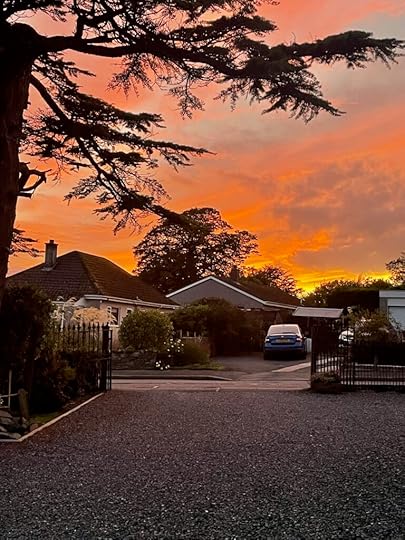 Sunset in Wigtown
Sunset in Wigtown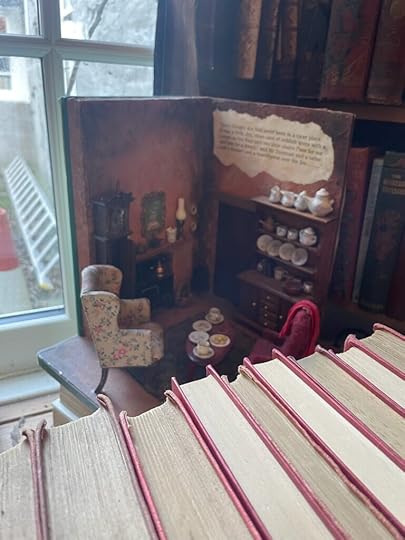 Display at a bookshop
Display at a bookshop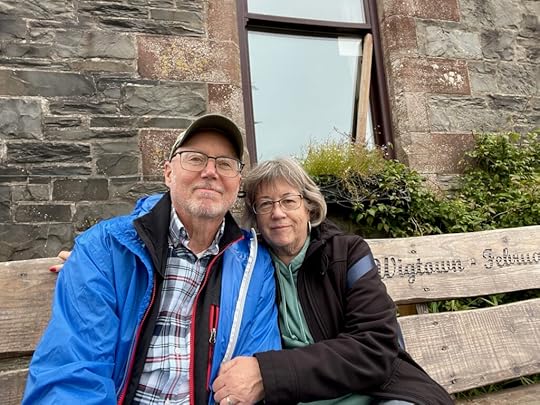 We are sitting in front of Hillcrest House
We are sitting in front of Hillcrest House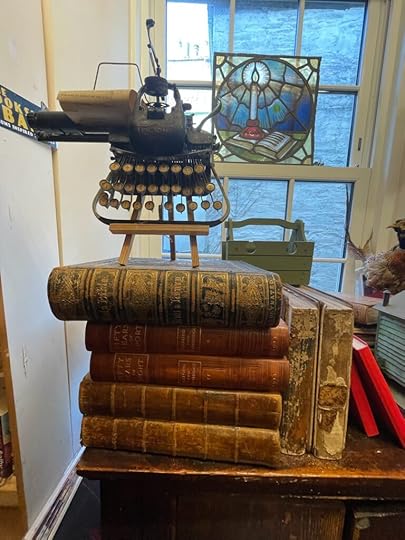 Display at a bookshop
Display at a bookshop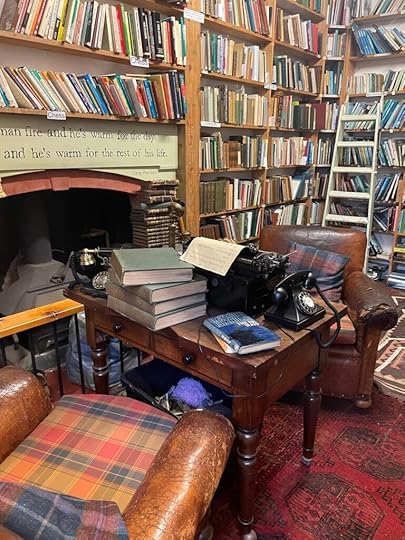 Inside a bookshop
Inside a bookshop Town square
Town square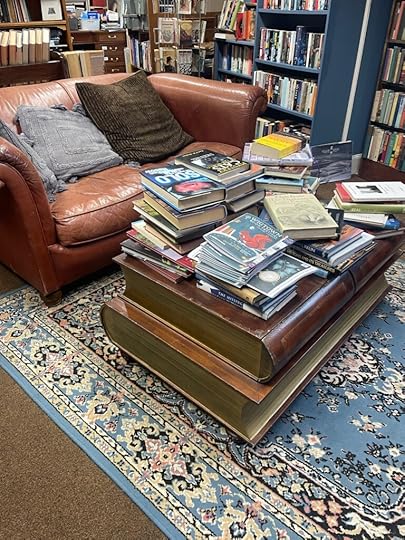 Inside a bookshop
Inside a bookshop Path to the bookshop pictured to the right.
Path to the bookshop pictured to the right. We bought some children’s books here.
We bought some children’s books here. View from the graveyard next to Wigtown Parish Church
View from the graveyard next to Wigtown Parish Church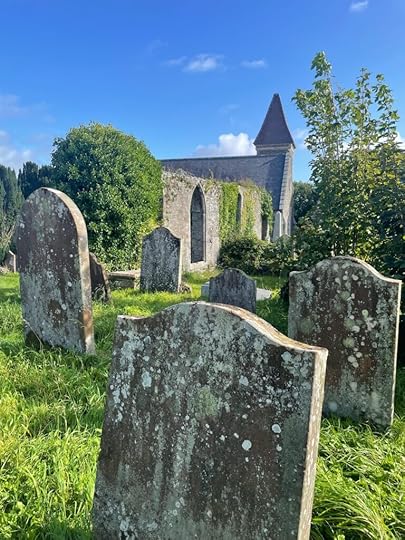 Wigtown Parish Church. There is a graveyard, a church ruin, and an operating church here.
Wigtown Parish Church. There is a graveyard, a church ruin, and an operating church here.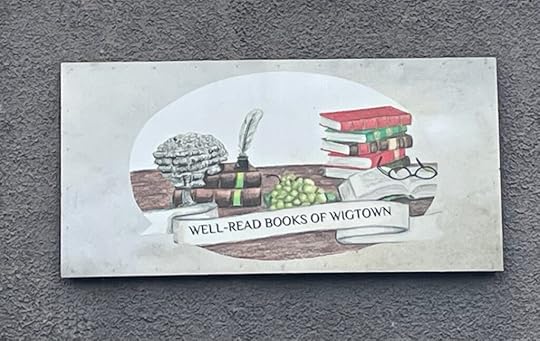
 Bench outside of Hillcrest House.
Bench outside of Hillcrest House.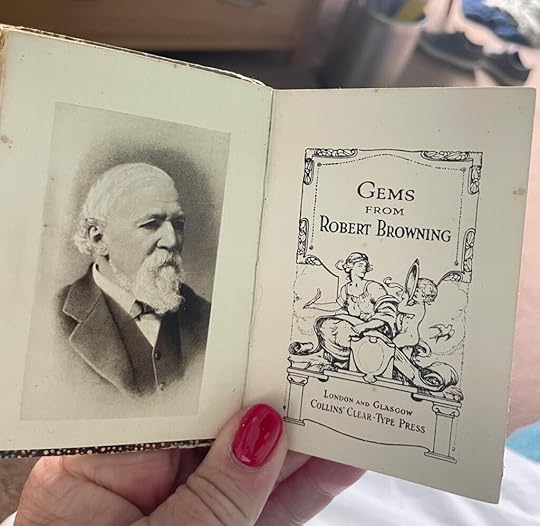 I picked up this miniature book at a bookshop for 1 pound.
I picked up this miniature book at a bookshop for 1 pound.
October 5, 2025
What I Saw in North Wales
North Wales is so beautiful it’s hard to believe it’s real! I went there because my Myrick roots came from there (it seems so anyway. We are talking 16th century at the dawn of the use of surnames.)
We arrived at our bed and breakfast the afternoon after our flight arrived in Manchester. We found our accommodations friendly and spacious with very nice guests from England. The breakfast was so wonderful!
There was a downside. There is a church directly across the residential street from our room with a bell tower that chimes on the hour. Very quaint, I thought. We’ve learned that what helps with jet lag (we didn’t sleep on the plane much) is to stay up until at least 8:30-9pm local time. I peacefully drifted off at 9pm. And then, the church chimes. Every hour on the hour all night long. Seems a couple of years ago there was a petition to silence them that failed. But that was the only downside.
Wales faces the ocean, which provides some beautiful beach views.
 ©2025CindyThomson
©2025CindyThomsonI did a little beach combing. Wish I had done more. Well, next time. Here’s what I found.
 ©2025CindyThomson
©2025CindyThomsonThe next day was my birthday and we started by visiting this waterfall. It was a bit of a hike. There was a spot where you could park and shorten the hike but the spaces fill up quickly and we were up to a longer hike. Glad we did because we walked through a gorgeous woodland.
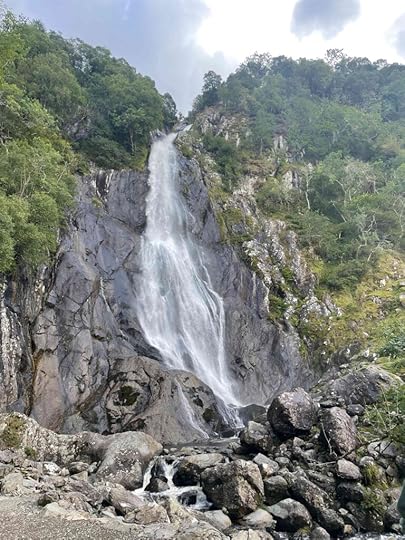 ©2025CindyThomson
©2025CindyThomson ©2025CindyThomson
©2025CindyThomson
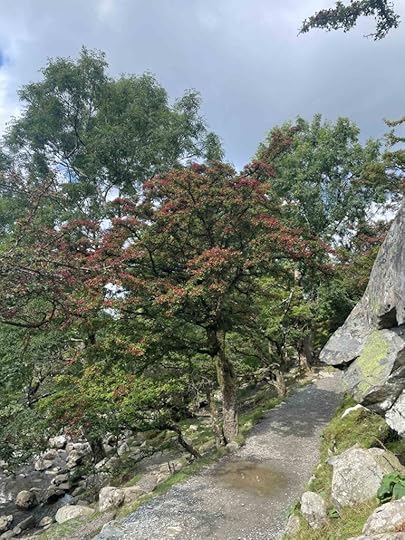 ©2025CindyThomson
©2025CindyThomson ©2025CiindyThomson
©2025CiindyThomsonThe next day we visited Caernarfon Castle, a medieval fortress in Gwynedd, north-west Wales. The oldest parts date to the 11th century! We climbed up towers and wandered all over. It was just amazing as were the views!
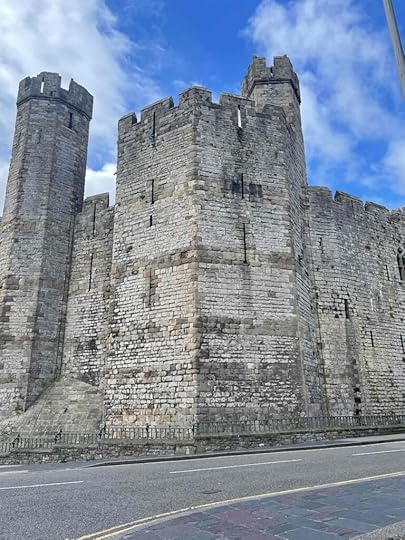 ©2025CindyThomson
©2025CindyThomson ©2025CindyThomson
©2025CindyThomson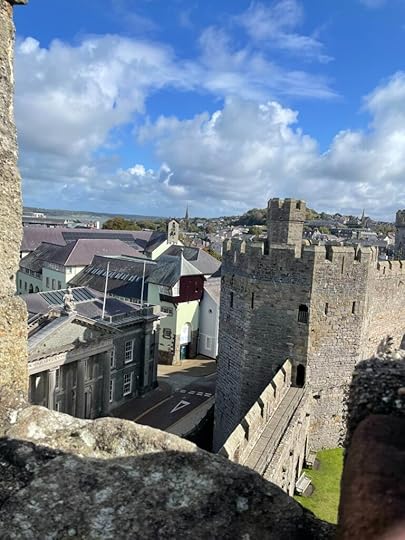 ©2025CindyThomson
©2025CindyThomsonThe town around the castle is very nice with some great shops. We got some advice for places to hike from a local shopkeeper. Actually, he said he was English, which in this case made him much easier to understand. Tip: follow the advice of locals!
After the castle we visited Bodorgan, which is where my Myrick family lived way back in the 16th century. There is a family estate there but we didn’t visit because 1. it’s a private residence and not open to the public and 2. it dates later than when my ancestors lived there. But I wanted to visit the area and we were advised to visit a church there. We got to the church, tiny, down a small lane, and there was a wedding going on! So we backed out and ended up visiting this sweet little cafe where we chatted with the owners and another couple eating there. We were even given a blessing on our journey in Welsh! Below are two photos I took in the cafe. See the shed out there? It holds a seating area for when people want to get outside but avoid the rain.
 ©2025CindyThomson
©2025CindyThomson ©2025CindyThomson
©2025CindyThomsonI just noticed the hummingbird sun catcher. There were also hummingbirds on the curtains at our BnB. It’s my understanding that hummingbirds are only found in North and South America. Hmm.
Then we went back to the church, St Cadwaladr’s Church, Llangadwaladr. According to Wikipedia, the church was first established on those grounds in the 7th century. The church standing today was built over several centuries, starting in the 12th century. You can see the additions in some of the photos. The north Chapel (Meyrick) was built c. 1640 and there are memorials to the family inside, which I didn’t see, not to mention the stained glass window pictured below.
It was during the Tudor period that the church was given stained glass windows as a gift from the Meyrick family (Welsh: Meurig) of Bodorgan as thankfulness for the return of their son Owain Ap Meurig after fighting with Henry Tudor at the Battle of Bosworth (1485). The window is dated to 1490, and the painting includes a portrait of St. Cadwaladr and also depictions of Saint Mary and St. John, the glass window was restored in 1850. The stained glass window from the 15th century was hidden in a vault during the Protestant reformation in 1661. The window of 1485 in the chancel east window also shows a Meyrick family member, Owen ap Meuric praying with his wife Ellen. (from Wikipedia https://en.wikipedia.org/wiki/St_Cadwaladr%27s_Church) you might want to visit that site as the photo of the window is a little blurry here, sorry.
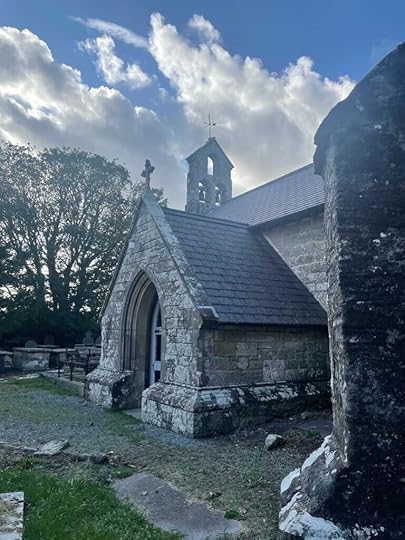 ©2025CindyThomson
©2025CindyThomson ©2025CindyThomson
©2025CindyThomson ©2025CindyThomson The gate to the kirkyard
©2025CindyThomson The gate to the kirkyard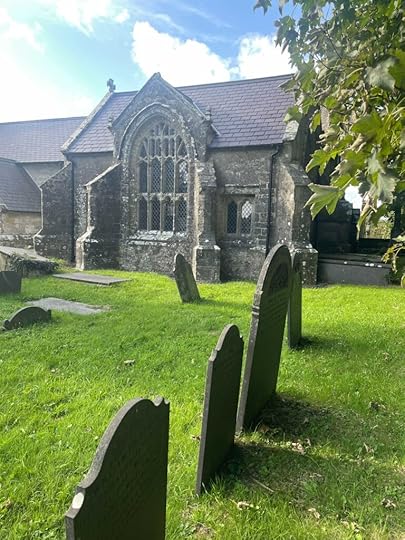 ©2025CindyThomson
©2025CindyThomson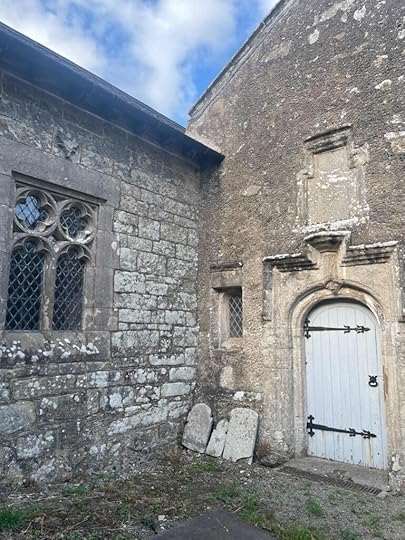 ©2025CindyThomson
©2025CindyThomson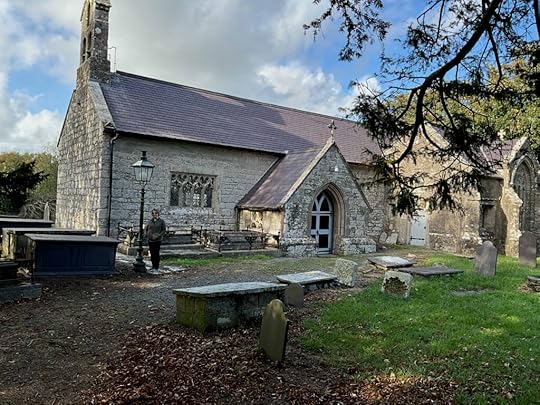 That’s me by the lamppost. ©2025CindyThomson
That’s me by the lamppost. ©2025CindyThomson By Monsyn – Own work, CC BY-SA 4.0, https://commons.wikimedia.org/w/index...
By Monsyn – Own work, CC BY-SA 4.0, https://commons.wikimedia.org/w/index...I wish I had the words to describe Wales. All I can say is it was like a fairytale, and we only went to the north. We definitely want to see the rest! Here are some pictures from the hike the English shopkeeper suggested we take.
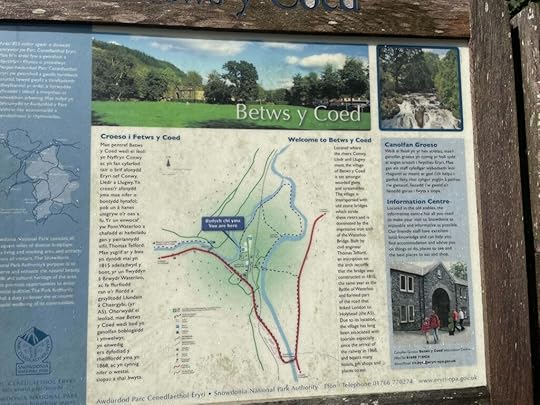
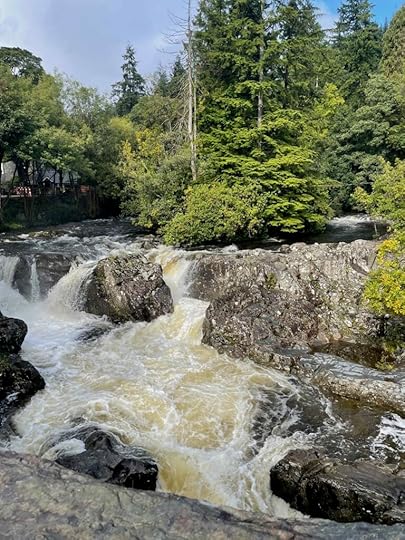
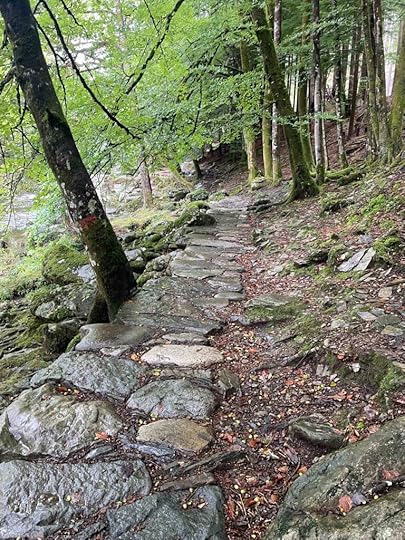
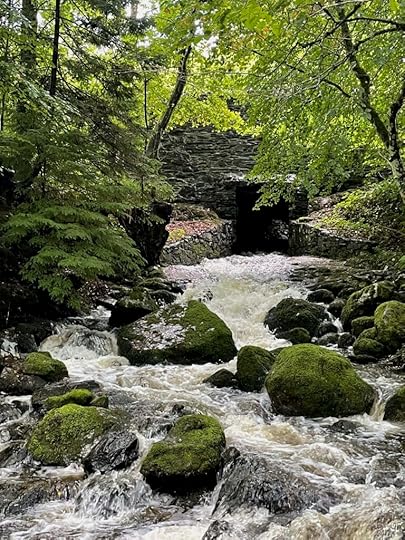
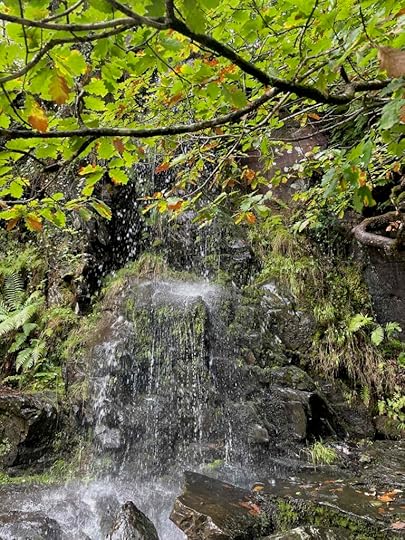

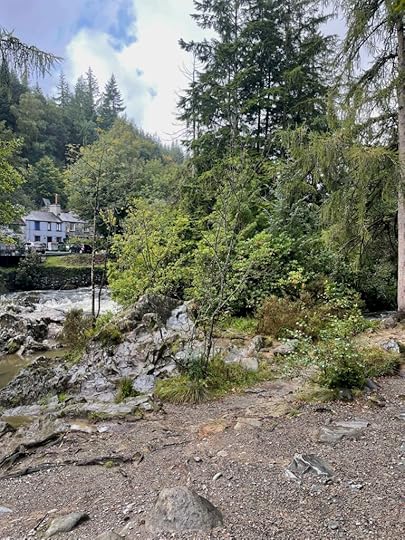
August 31, 2025
A Celtic Labor Day
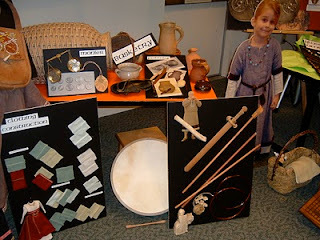 Examples of Celtic labor from the Book of Kells Exhibit, Washington-Centerville Library
Examples of Celtic labor from the Book of Kells Exhibit, Washington-Centerville Library
Although Labor Day is an American holiday, it still makes me think about the Celtic people. The Carmina Gadelica* is filled with prayers and songs for times of labor. There is a whole section devoted to labor. The people took God with them wherever they went and included Him in whatever they were doing.
God, bless Thou Thyself my reaping.
Each ridge, and plain, and field,
Each sickle curved, shapely, hard,
Each ear and handful on the sheaf.
Each ear and handful on the sheaf.*
I often ask myself if I do this. I think the very fact that I have to ask means I don’t, or I don’t nearly enough take God with me in my everyday tasks. Many Christians have a time of devotion or quiet prayer, and when I do this myself, I find myself often questioning whether I’m sticking God into 15 minutes a day and leaving Him out of the rest.
The Celtic people clearly had a different mindset. There was no separating God from the world. God is not only in the world, He is life, the very reason the world exists.
Through him all things were made; without him nothing was made that has been made. In him was life, and that life was the light of men. The light shines in the darkness, but the darkness has not understood it. ~John 1: 3-5 NIV
I AM smooring the fire
As the Son of Mary would smoor;
Blest be the house, blest be the fire,
Blest be the people all.*
I have blogged about the Carmina Gadelica many times before (see this search) and probably will again. It’s a wonderful collection that illuminates the spiritual belief of the ancient Celtic people.
I will give thanks to the King of grace
For the growing crops of the ground,
He will give food to ourselves and to the flocks
According as He disposeth to us.*
Summer is Gone
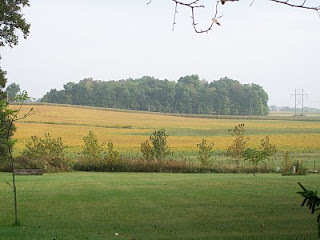 ©Cindy Thomson
©Cindy Thomson
Summer is Gone
Ancient Irish poem translated by Kuno Meyer
My tidings for you: the stag bells,
Winter snows, summer is gone.
Wind high and cold, low the sun,
Short his course, sea running high.
Deep-red the bracken, its shape all gone–
The wild-goose has raised his wonted cry.
Cold has caught the wings of birds;
Season of ice–these are my tidings.
 ©CindyThomson
©CindyThomson
The Wild Goose
These are the words to a song by the band Iona. The term wild goose in the Celtic Christian tradition refers to the Holy Spirit. You can hear the song in the video below. It’s such a beautiful song.
HERE I STAND
Here I stand, looking out to sea
Where a thousand souls have prayed
And a thousand lives were laid on the sand
Were laid on the sand
Years have passed, since they have died
And The Word shall last
And the Wild Goose shall fly
Shall fly
 Photo by Egemen Şahin on Unsplash
Photo by Egemen Şahin on UnsplashHere I stand, looking out to sea
And I say a prayer
That the Wild Goose will come to me
The Wild Goose shall come to me
~Iona
July 31, 2025
The Legend of The Giant’s Causeway
This post originally appeared on an older blog in 2010.
 ©2010 Cindy Thomson
©2010 Cindy Thomson
We know that the rock at the Giant’s Causeway was the result of cooling lava compressed together millions of years ago (at least most people think it was millions of years ago.) This black rock is basalt and it’s a natural wonder.
But what did the ancient people think when they saw it? They were no less intelligent but the study of rocks and the earth’s composition was not part of their world. So what did they think when they gazed over the cliffs toward the sapphire blue ocean and see these rocks trailing out toward Scotland? (but disappearing before they reached it.) What they did was explain the
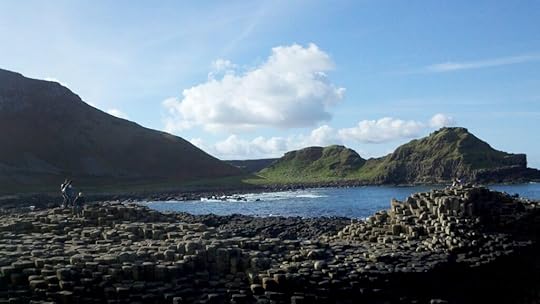 ©2010 Cindy Thomson
©2010 Cindy Thomsonwonder in the traditional Irish way: they made up a story about it. This was not a manmade structure. No man could have done this, certainly. The gods? Well, maybe, but the gods are credited with all kinds of things. What if this was the work of a man–not an ordinary man, but a super hero?
They didn’t use the term then, of course. This was the work of a giant, a mighty warrior. A giant named Fin MacCool or Fionn mac Cumhaill in Irish.
It seems Finn had a rival giant over in Scotland by the name of Benandonner. The two giants would shout to each other over the sea, challenging each other’s strength. Nothing could be done about it, so Finn started building the causeway to reach the other giant.There are different versions of this story, but basically, when the Scottish giant started coming toward him, Finn realized how much larger he was. Using his sharp Irish intellect, he came up with a plan. He made himself a bed out of the rock and either went to sleep or pretended to be asleep. (I’d go with the latter. A bigger giant was after him! How could he fall asleep?) He pretended to be a baby while Finn’s wife entertained the other giant by giving him tea made with stones and telling him MacCool would return shortly. As he chewed on the tea, Benandonner thought to himself, “This MacCool must be a tough one to drink this stuff.” Then he noticed the “baby” asleep in his bed and thought, “If this is the size of the baby, how big is his father?” He reached out to touch the child and got his finger bitten clean off. Then he thought, “If the baby can do that, what is the father capable of?” Terrified, he ran off toward his home, tearing up part of the causeway as he went. That’s why today it disappears into the sea.
This explanation of the existence of the causeway makes sense to me. How about you? 
July 14, 2025
El Roi-The God Who Sees
Have you ever felt unseen, unnoticed, overlooked? Yeah, me too. I want to tell you something that happened to me. I hope it encourages you.

Last weekend I attended the Columbus Book Festival representing the Faith & Fellowship Book Festival. It was a good weekend despite a few showers on Saturday. My friend, author Sandra Merville Hart, and I talked to a lot of people, heard a lot of stories, and were blessed by so many who took the time to tell us they valued our mission of bringing readers and Christian authors together.
I had what Christians call a “God moment.” Something that tells you without a doubt you have received a message from God. Let me set the stage first with a confession of doubt and pouting. In 2017 I went to the Christian Fiction Readers Retreat as one of their featured authors. These were events that bring readers and authors together for a time of games and fellowship. It was held in Cincinnati so not too far. My husband went with me. He remembers my mood still.
It was huge. There were lots of best selling Christian novelists in attendance. I truly had no idea what it was like before I went. I did get to reconnect with some author friends like Rachel MacMillian and Rachel Hauck and Becky Waters. I met Carrie Turansky who was so encouraging to me. Even so, I felt like a fly on the wall. And then came the game that made me feel it was true: I didn’t really belong there. I felt unseen, unappreciated. (Which was silly given the hugs I got from the women I just mentioned.)
The game had a panel (authors and readers, I think) that had a limited time to guess the title of a book based on clues they were given. These were all books by the featured authors. There was one of these “big” authors on the panel. She was an extrovert, a big talker, a big seller–in other words, the opposite of me. They were giving clues about my book, Brigid of Ireland. Stuff like, ancient, saints, Ireland…None of the guesses were correct. The “big” author threw her hands up in the air and said, “But what else could it be?” I felt awful in that moment. I might have been thinking back to another awful moment.
In high school I qualified for my only advanced class: Advanced Exposition, an English class where you wrote essays. The day after we turned the first one in, the teacher began reading without identifying who the writer had been. It was my essay. An example of good writing? Nope. He proceeded to pick it apart and point out every error. I wanted to climb under my desk. Unworthy? Unvalued? I felt all the un-things that day. I abandoned creative writing for many years after that. So maybe that day in Cincinnati I went back there in my mind. A familiar and unwelcomed moment for sure.
As I said, that readers retreat wasn’t all bad. In one session, I don’t remember if it was the guessing game or not, I sat next to a young girl who told me she was also from the Columbus area. She was very nice. As I remember, the only reader I interacted with there. That was likely my fault given my foul mood. I sold one book while I watched other authors signing several. I think maybe it was this young girl who bought it but I don’t remember now for sure.
Fast forward eight years to the Columbus Book Festival. I had just returned to the tent from a bathroom break to see my husband talking to someone. She was looking for me. “Do you remember coming to an event in Cincinnati a long time ago? I sat next to you.” She remembered my book with a camera on the front (Grace’s Pictures.) Yes, of course I remembered! Did I ask her name? No. I regret that. If she’s reading this, please contact me! Girl, you have no idea what your parting words did for me, a message that God sees, like Hagar calling him El Roi, the God who sees. Those parting words? “Keep writing good books.”
I hope this encourages you. And please, please, watch these clips. They immediately came to my mind.
(There are probably ads but hang with it. Click to watch on YouTube)
June 4, 2025
Why I Went North, a post from 2010
This post first appeared on an older blog in 2010. Thank goodness cellphone photos have improved!
This picture is in Downpatrick on a street where my Little ancestors probably walked.
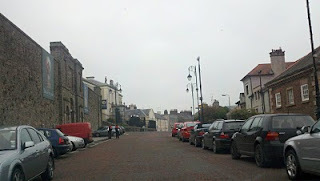 ©2010CindyThomson
©2010CindyThomsonTom and I spent most of our trip to Ireland in the north. That sounded odd both to people here and to the people in Northern Ireland. But I don’t regret the decision. Many of the sites I’ve written about are in Northern Ireland, as were some of the friends I had met over here. We didn’t often run into other Americans while we were there. Wherever we went, after we spoke to someone, they looked surprised and said, “You’re Americans!” They would always ask us where we were from. When we said Ohio, they said, “Oh” and nodded their heads. We told them it was okay if they didn’t know where Ohio was. Many of them had been to New York,Boston, California, or Florida. “We’re in the middle,” we told them.
I think more tourists should go to Northern Ireland. It’s beautiful, uncrowded, and welcoming. There is just as much history and ancient ruins and such. We ate at some wonderful places in small towns.
Many of the tourists who do go to Northern Ireland go there to research their ancestry. We didn’t do any research on this trip,
 ©2010CindyThomson
©2010CindyThomsonbut we did note the places that our ancestors
came from. Mine were from Downpatrick, County Down, and Tom’s from Magherafelt, County Londonderry. Driving through the countryside where they probably roamed and on the street where they probably drove their
wagons or carts was inspiring. I’ve done the same thing in parts of this country where my ancestors lived. You can tell why they settled in eastern Pennsylvania (Tom’s ancestors) and the Shenandoah Valley of Virginia (my ancestors) when you see what that part of Ireland looks like. They felt at home with the landscape, I’m sure.
When we go back to Ireland (we were talking about going back before we even left)
I want to see other areas of Ireland, and Scotland too. But this time I got to go where I wanted to go. I’m sitting at my computer now and wishing I was back there. That memory of green will never leave me. It was amazing.
 ©2010CindyThomson
©2010CindyThomson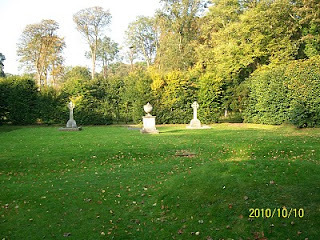 ©2010CindyThomson
©2010CindyThomson
.
May 9, 2025
The Feast of St. Comgall
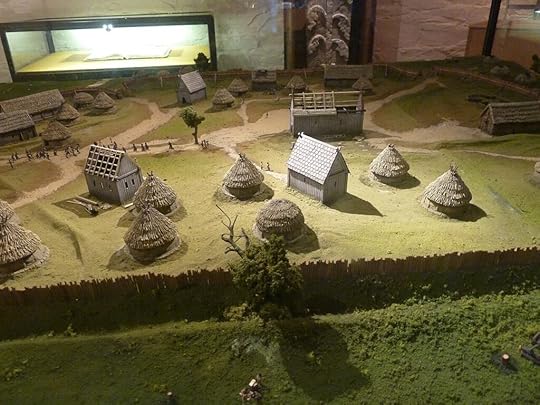 Model of Bangor Abbey 688 AD. This file is licensed under the Creative Commons Attribution-Share Alike 3.0 Unported license. Photo by Notafly
Model of Bangor Abbey 688 AD. This file is licensed under the Creative Commons Attribution-Share Alike 3.0 Unported license. Photo by NotaflyToday is St. Comgall Day. He was the founder of the monastery at Bangor in Northern Ireland. The Irish Annals place his birth between 510 and 520 and his death around 602. He was born in the ancient kingdom of Dalaradia in Ulster, in today’s County Antrim. He may have first been a soldier and then studied under Finnian in Conlard, along with the other great monastic fathers. He practiced a strict form of Christian monasticism on an island on Loch Erne. Only one meal per day and that eaten in silence. Of all his monastic settlements, the most famous is at Bangor in present day County Down on the southern shores of Belfast opposite Carrickfergus. Bangor’s picturesque setting is well known. (Read more about Bangor here.)
Bangor was established sometime between 552 and 555. The Rule of St. Comgall survives from the 7th century in the Ambrosian Library at Milan and is referred to as The Antiphonary of Bangor. It was carried to Bobbio at some point in history by an Irish monk. Comgall oversaw his monastery for 50 years. It was known all over Europe as a great center of learning. As many as 3,000 monks may have studied there at one time and the monastery prospered until the Dane invasion of 822. The abbey was rebuilt in the 12th century and modeled after Armagh, the largest church in Ireland at the time. Learn more about that here.
The Northumbria Community created this prayer based on the Rule of St. Comgall:
Help us to preserve Your rule, Lord Jesus, and avoid transgressing it all of our lives. May we love You and hate wealth, be devoted to You and show kindness to all people. Lead us on to the path of repentance, advancing one step every day, not charging ahead like a charioteer. Amen.
April 15, 2025
Shipbuilding
This post originally appeared on an older blog in 2011.
The Vikings were conquerers largely because of their ships. Whether it’s the Viking influence or something else, Belfast has been building for a long time. Even before the Vikings, however, the Irish were boat builders. They may not have had longboats, but they may have built a vessel that actually sailed all the way to America in the 6th century!
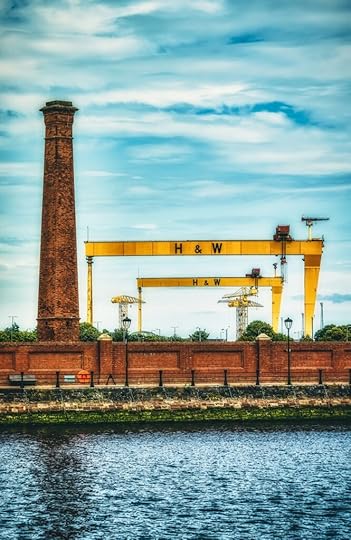 Photo by K. Mitch Hodge on Unsplash
Photo by K. Mitch Hodge on UnsplashBelfast’s location makes the city a major port for trade. You might remember that the Titanic was built in Belfast. As the Irish like to say, “She was fine when she left here!”
When Tom and I were in Ireland in 2010, we were invited to a two-man play titled The Boat Factory. It was about a young man’s experience post WWII working on the shipbuilding docks. Here’s a summary:
Belfast 1947. The sun shines down on a post-war world. A 16 year-old boy starts life as an apprentice at Harland & Wolff’s Titanic Shipyard. 1700 ships built between here and the Clyde, 67 different trades, 300 acres of land and 35,000 men employed at its height. Regarded as the biggest and best there is, if you can dream it they can build it. This is history – this is his story – this is The Boat Factory.
While we didn’t always understand the jokes or the accent of the actors, we did enjoy this unique Irish experience. Shipbuilding has been a critical part of life in Belfast for a very long time.
My ancestors, the Littles, sailed from Belfast in 1771. They lived somewhere near Downpatrick, which today is about a 45-minute drive from Belfast, the port they left for America. The Littles were not shipbuilders but they did board a ship that could have been Irish built. I’ve been trying to figure out just what the docks looked like in 1771. Not much luck so far. If you have any resources for me, please share!



